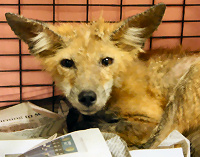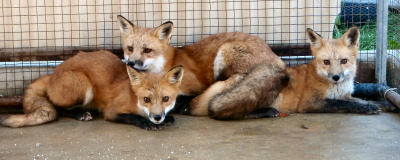Hunter, Chase, and Todd
Over the summer, a red fox had her litter in a yard in West Allis.
 The yard belonged to Ron, and he was well aware of the mother and her kits. He was “tickled pink” that he was able to watch from his kitchen window as the family of red foxes grew-up. He enjoyed watching them play and tussle with each other. But as time progressed, Ron noticed them losing their fur and looking less lively. So one day he walked into the Wisconsin Humane Society Wildlife Rehabilitation Center, looking for help. He explained his situation. Our wildlife rehabilitators listened to Ron’s description of the foxes and suspected that they were suffering from mange.
The yard belonged to Ron, and he was well aware of the mother and her kits. He was “tickled pink” that he was able to watch from his kitchen window as the family of red foxes grew-up. He enjoyed watching them play and tussle with each other. But as time progressed, Ron noticed them losing their fur and looking less lively. So one day he walked into the Wisconsin Humane Society Wildlife Rehabilitation Center, looking for help. He explained his situation. Our wildlife rehabilitators listened to Ron’s description of the foxes and suspected that they were suffering from mange.
What is Mange?
Mange is a skin disease caused by mites.
The mites burrow into the skin, causing horrible itching. The mites cause the victim’s skin to overproduce skin cells, which leaves a thick crust after the hair falls off. This thick crust, which can be up to an inch thick, cracks, and painfully exposes flesh which is then susceptible to infection. Animals with mange usually suffer from emaciation and dehydration because their eyes crust over and they are unable to hunt for food.
Capturing Hunter
We loaned Ron a fox-sized live-trap and showed him how to use it.
We cautioned Ron that foxes are wary animals and are usually very challenging to catch. Persistence paid-off and soon Ron had caught the first fox. He brought the fox into WHS and our rehabilitators were correct, the diagnosis was indeed mange, as well as dehydration and emaciation. Before we could get started removing the crust with a series of medicated baths, we needed to improve the condition of the fox so that he could handle anesthesia. We immediately started fluid therapy. Over the course of a few days, our little fox gained strength. We named him Hunter.
Capturing Chase and Todd
Just as we were starting to feel confident that Hunter would make it, Ron called us.
He found a second fox with mange sleeping in his window well and he had contained him in the well. We sent one of our most experienced wildlife rescue volunteers out on the call. This fox was in rough shape. As soon as he arrived at WHS, we started the process of rehydration and supportive care. He ultimately did well too. We named this one Chase. By this time, Hunter had already had a few baths. His eyes were clear and he was starting to grow some fur back. But then just as Chase had recovered enough strength to be able to have his first bath, Ron called again! In came the third fox, another boy. We named him Todd, after the fox character in the Disney movie “The Fox and the Hound”. Todd had taken the longest to catch, and he was in the worst shape of them all. We crossed our fingers as we administered fluids and started treatments.
Rehabilitating the Foxes
Over the weeks, the three foxes thrived and their playful spunk returned.
After their treatments and baths were complete, we moved them to a spacious outside habitat. We gave them lots of toys and enrichment opportunities to keep them entertained.
Releasing Hunter, Chase, and Todd
After about a month outside, they had grown nice, thick winter coats and they were finally ready for release!
 Weeks earlier, Ron had obtained the help of the West Allis Fire Department to flush water through the old drain pipe the foxes’ parents had used for a den. This was needed to make sure the foxes wouldn’t get mange again, if they went back into their old den. With this done, we were able to return the foxes to Ron’s yard. We carried the foxes’ pet carrier to the backyard, where members of the media, some of our Wildlife Center staff and various neighbors and other interested parties had gathered for the event. We popped-open the carrier door and out they ran in single file, one, two, and three. Against all odds, they made it back to where they were born. It was a fantastic day! Ron is now a dear friend of the Wisconsin Humane Society Wildlife Rehabilitation Center and its staff. He has helped rally donations from friends and neighbors, as well as supplying us with updates about how the foxes are doing. Now all Ron is hoping for are three lady foxes to find the three “boys” in his back yard.
Weeks earlier, Ron had obtained the help of the West Allis Fire Department to flush water through the old drain pipe the foxes’ parents had used for a den. This was needed to make sure the foxes wouldn’t get mange again, if they went back into their old den. With this done, we were able to return the foxes to Ron’s yard. We carried the foxes’ pet carrier to the backyard, where members of the media, some of our Wildlife Center staff and various neighbors and other interested parties had gathered for the event. We popped-open the carrier door and out they ran in single file, one, two, and three. Against all odds, they made it back to where they were born. It was a fantastic day! Ron is now a dear friend of the Wisconsin Humane Society Wildlife Rehabilitation Center and its staff. He has helped rally donations from friends and neighbors, as well as supplying us with updates about how the foxes are doing. Now all Ron is hoping for are three lady foxes to find the three “boys” in his back yard.
Thank you for your support
Please consider making a donation in honor of Hunter, Chase, and Todd, or donate items from our wishlist. Thank you so much.
We could not have saved these three beautiful creatures without the generous donations of people like YOU.
